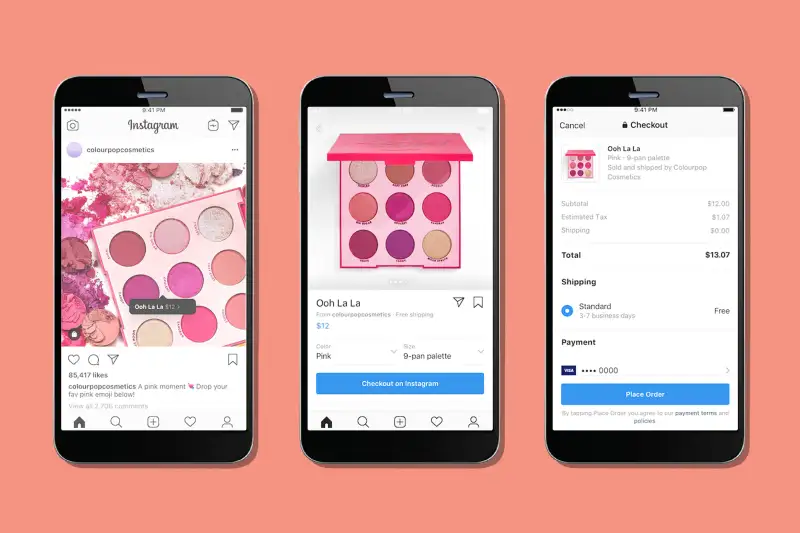'Danger, Danger, Danger!' Why You Should Avoid Instagram Shopping Like the Plague, According to a Consumer Psychologist

This week, Instagram unveiled a long-awaited feature: a shopping checkout within the app itself. It's called Checkout on Instagram, and I think its sole purpose is to make you go into debt.
No more onerous clicking through to a retailer’s website, no pop-ups telling you to authorize the use of cookies—basically, there’s zero friction to go from “ooh, nice shirt” to “your order is on its way.”
Currently, the Checkout on Instagram feature is in closed beta with 23 retailers onboard, ranging from high-end (hello, Balmain and Burberry) to reasonably priced and trendy (Warby Parker and Uniqlo).
It's disturbingly easy to buy stuff on Instagram. First you tap a photo in a participating retailer’s feed. That leads you to a product page with a photo and details like colors, sizes, and price. Enter your credit card number (or PayPal details) and address, place an order, and poof—your new necklace/linen shirt/high-impact mascara is on its way. Your next time shopping at Instagram can be even quicker, because the app saves your card info and other personal details for future purchases across all retailers.
In the interest of research, I took Checkout on Instagram for a spin. After 10 seconds on H&M’s Instagram, I saw a shirt I sort of liked, clicked through, and bought it for $17.99. The whole process took 30 seconds.
I’m not a hardcore shopper, but it sure seems like the financial repercussions of scrolling on Instagram for an hour could be very serious. To get some perspective and advice for shoppers, I called Kit Yarrow, a consumer psychologist and author who’s an expert on consumer behavior. The first thing she said when I mentioned Instagram's new Checkout option?
“Danger, danger, danger!”
Social Media, Self-Esteem, and Impulse Purchases
Surveys have shown that heavy Instagram use is associated with feelings of inadequacy and low self-esteem, not to mention heavy cases of FOMO. Impulse buying is connected to the very same emotions that crop up when you’re scrolling other people’s lives in Instagram and pondering about how picture-perfect they seem. (We reached out to Instagram for comment and will update the story if we get a response.)
Feeling bored? Lonely? Envious? Need to self-soothe? You’re one tap away from a different life and the high-waisted linen pants you’ve always dreamed of!
Yarrow says that combining combining social media and shopping can be a very dangerous concoction, especially for tend to buy stuff unnecessarily or live on credit. Her biggest piece of advice is to try to remove the temptation entirely.
“If you’re on a diet, you don’t go into a bakery,” says Yarrow. “If you’re trying to save money, you don’t go shopping. But now that shopping comes to us, it’s like having a plate of donuts sitting in front of you at every moment.”
And you're going to want to eat when you're not even hungry. Was I interested in buying strange mesh sneakers from Zara for $69.90? Not really—until I saw that its corresponding post had 186,475 likes and 871 comments. Maybe these are *in* right now, I thought. If strangers like it, shouldn’t I?
The Secret to Resisting Shopping Temptations
Yarrow advocates unsubscribing from store-related emails featuring discounts and deals—and the same rule holds true for social media. You can unfollow brands before you get into the habit of buying online. (For now, the checkout feature on Instagram is only available on images in the main feed and Instagram Stories, not on advertisements that are pushed to you.)
“The more contact we have with a product, the more comfortable we feel owning it,” says Yarrow.
We are particularly likely to buy products that follow us around and linger, she says. It’s the reason why brands pay for those stalker ads that keep appearing online after you look at an item once. The creepy becomes the familiar—and then becomes the next package dropped off on your doorstep.
Try the 20-Minute Rule Before Buying
Yarrow says if you’re frequently caught in a loop of impulse buying, it’s good to set self-imposed limits. Tell yourself, “I don’t need to buy this now, but I’ll wait 20 minutes and come back.” After that time has passed, ask yourself if you even remember what you wanted to buy. Often, you won’t, she says.
There is also a way to save products in Instagram to look at later. I saved those mesh sneakers while debating whether I could be That Person Who Wears Mesh Sneakers. (Twenty minutes later, I had an answer: No, I could not. Purchase averted.)
Whether you're shopping on Instagram or anywhere else, it's wise to take some time to consider whether you truly need whatever you’re clicking in a fit of boredom. Save yourself the money, and the hassle of printing out return shipping labels (the pain of which is always a potent reminder of your saggy willpower). If you love Instagram, limit your scrolling to cute animal photos and images of beachside margaritas. Because it’s probably only a matter of time before you can buy those with one tap, too.
And when all that fails? Read the fine print: All Instagram orders can be canceled within 30 minutes.